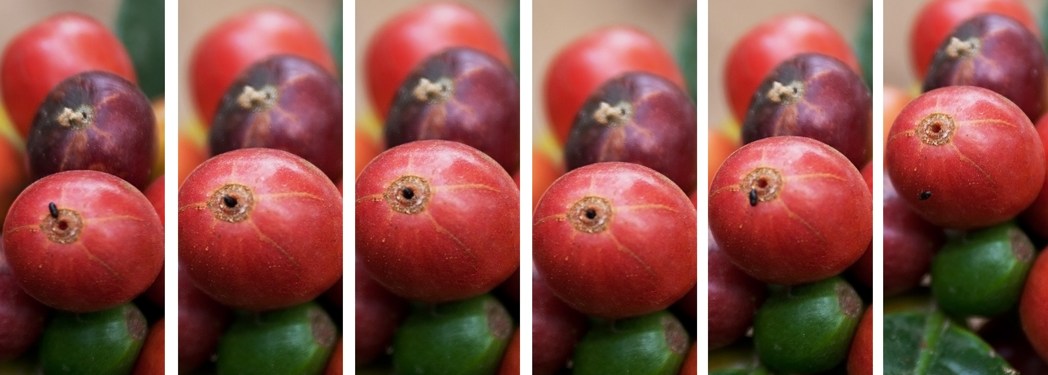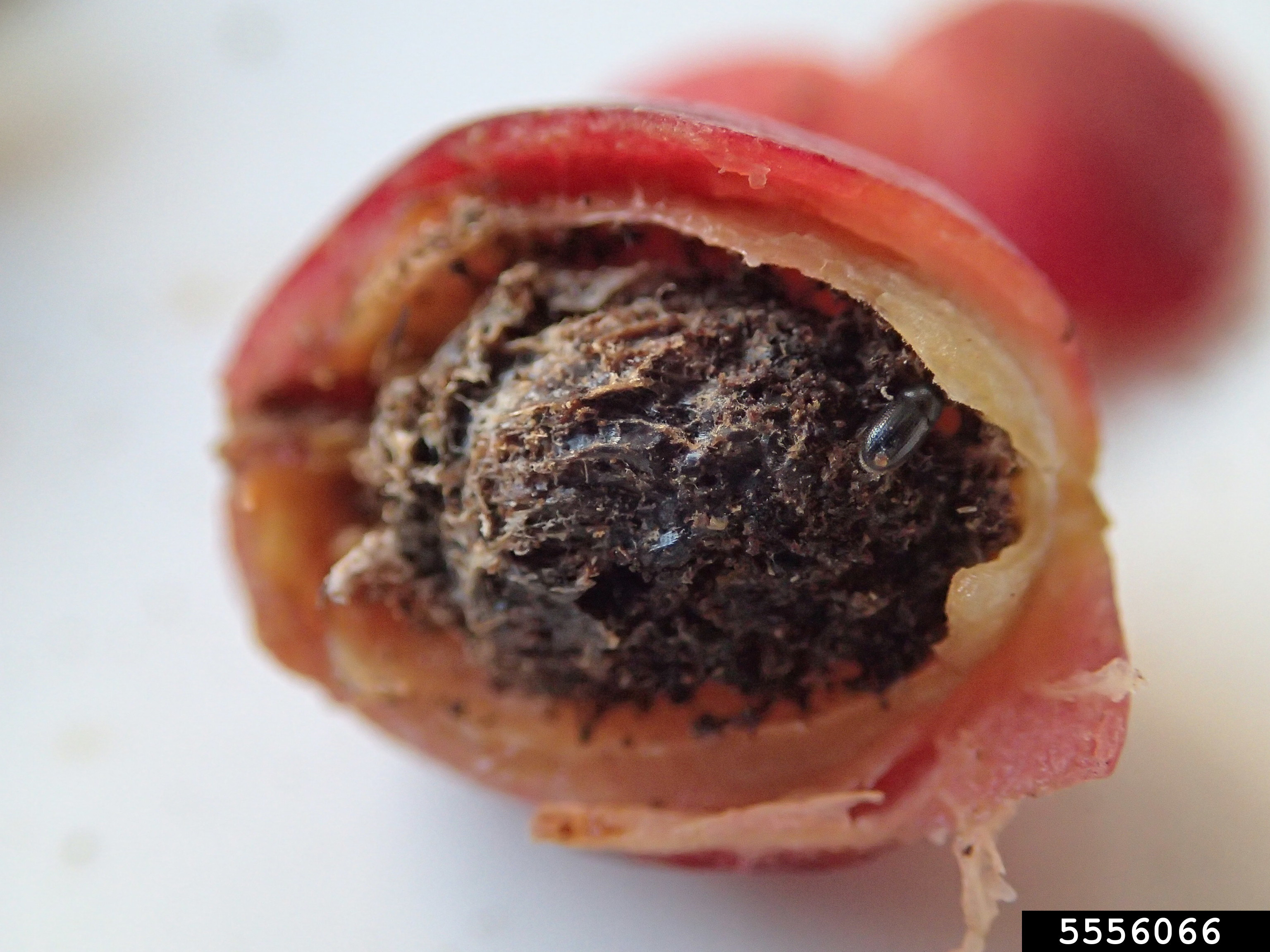
Introduction
Hypothenemus hampei, coffee berry borer (CBB) is the most economically important coffee pest in the world. The female bores a hole in the coffee cherry and deposits eggs in the fruit. Once the eggs hatch, the larva feed on the seed of the fruit (Burbano, Wright, Bright, & Vega 2011). The damage to the fruit and seed reduces quality and yield (Figure 3).
Lifecycle
The full lifecycle of H.hampei is completed in 28 - 35 days. Eggs hatch in 5 - 9 days and are laid by the female over the course of about 60 days. Once hatched, the larva can feed on the coffee seed for 10 - 16 days. Female larvae molt twice and then pupate for 4 - 9 days. Once a female emerges she becomes fertile shortly thereafter. Once inseminated, new females leave the cherry and take flight to find a new host. Females can live up to 157 days and can produce up to nine generations in one year if cherries are available year-round (Waller, Bigger, Hillocks, 2007). The mother does not leave an established cherry.
Males, which can not fly, remain in the fruit their entire life (Burbano, Wright, Bright, & Vega 2011) and fertilize females soon after the female emerges and becomes fertile. A single male can fertilize up to 30 females and can live up to 87 days (Waller, Bigger, Hillocks, 2007). CBB has a haplodiploid mating system with a roughly 10:1 female-to-male sex ratio (Aristizábal, Bustillo, & Arthurs, 2016).
Notable visual and olfactory attributes
The female CBB has larger eyes and shows a preference for the colors black and red when seeking new fruit to infest. The female is also able to detect kairomones (alcohols) released by a ripening cherry. (Aristizábal, Bustillo, & Arthurs, 2016)
Damage
The female bores into the coffee cherry, near the apex (Figures 1 & 2) and prefers more mature fruit (greater than 120 days from flowering), which allows easier excavation by the female (Waller, Bigger, Hillocks, 2007; Aristizábal, Bustillo, & Arthurs, 2016). The female excavates galleries inside the cherry in which to lay eggs at a rate of 2 - 3 eggs a day continuously for up to 20 days before needing to rest (Aristizábal, Bustillo, & Arthurs, 2016). Once hatched, larvae then feed on the seed as they bore through it.


Because the female prefers cherries colored red or darker, overripe, or raisin cherries still on the plant, as in Figure 4 and those on the ground are popular sites for infestation.

Monitoring
Traps containing alcohol can be deployed to detect activity of new, inseminated females seeking a host plant. Effective traps are colored red or white and contain either a 3:1 or 1:1 ratio of methanol to ethanol (Messing, 2012).
Control
Cultural control
Preventative, cultural practices with an intensive effort at field sanitation have proven to be the most effective measure against CBB (Waller, Bigger, Hillocks, 2007; Aristizábal, Bustillo, & Arthurs, 2016). It is critical to harvest fruit at optimal maturity and not leave overripe fruit—which is preferred by the insect—in the field.
- Remove and destroy debris, especially fallen fruit, from around the base of coffee trees.
- Harvest cherries as soon as economically feasible.
- Re-harvest each tree frequently during the harvest season.
- Do not allow cherries to overripen on the tree.
- Strip-pick each tree at the end of the harvest to ensure no fruit remains.
Biological control
Biological controls will likely be less effective (possibly even unnecessary) if proper field sanitation practices are followed as in the section “Cultural control.”
- Parasitoid wasps Cephalonomia stephanoderis, and Prorops nasuta target the CBB larvae and pupae and Phymastichus coffea targets the adult CBB.
- Generalist predators of CBB can include:
- Ants (Solenopsis geminate, Dorymyrmessp. Pheidolesp., Mycocepurus smithii, and Tetramorium bicarinatum).
- Thrips (Karnypthrips flaves)
- Flat bark beetle, (Cathartus quadricollis)
Sprays
The fungus Beauveria bassiana has proven effective in some Central and South American countries and Hawaii—some formulations are approved in Certified Organic production (CBB Control, n.d.)
Insecticides pose a challenge because CBB spends most of its life inside the fruit, protected from insecticides. Some older literature references the effectiveness of endosulphan. However, it is being phased out of use globally due to its toxicity to both insects and mammals. Note that the US EPA does not allow endosulphan residue on coffee (Tolerances And Exemptions For Pesticide Chemical Residues In Food, 2017). Detected residue would prevent the sale within the US.
Aristizábal, L. F., Bustillo, A. E., & Arthurs, S. P. (2016). Integrated pest management of coffee berry borer: strategies from Latin America that could be useful for coffee farmers in Hawaii. Insects, 7(1), 6.
Burbano, E., Wright, M., Bright, D. E., & Vega, F. E. (2011). New record for the coffee berry borer, Hypothenemus hampei, in Hawaii. Journal of Insect Science, 11(1).
CBB Control. (n.d.). Hawaii Coffeeed. Retrieved July 16, 2020, from https://www.hawaiicoffeeed.com/cbb-control.html
Cranshaw, W. (2017, November 30). [Picture of severe insect damage to coffee cherry] [Photograph]. Bugwood.org. https://www.ipmimages.org/browse/detail.cfm?imgnum=5556066
Cranshaw, W. (2017, November 30). [Picture of entry wounds near the apex] [Photograph]. Bugwood.org. https://www.ipmimages.org/browse/detail.cfm?imgnum=5556067
EPA Tolerances And Exemptions For Pesticide Chemical Residues In Food, 40 C.F.R. § 180.182 (2017). https://www.govinfo.gov/content/pkg/CFR-2017-title40-vol26/xml/CFR-2017-title40-vol26-part180.xml#seqnum180.182
Messing, R. H. (2012). The coffee berry borer (Hypothenemus hampei) invades Hawaii: Preliminary investigations on trap response and alternate hosts. Insects, 3(3),640-652.
Waller, J. M., Bigger, M., & Hillocks, R. J. (2007). Coffee pests, diseases and their management: CABI.
Wikipedia contributors. (2020, June 29). Endosulfan. Wikipedia. https://en.wikipedia.org/wiki/Endosulfan#Health_effects
